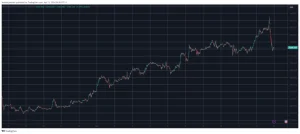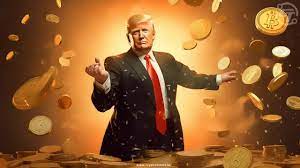Gold’s Price Also Drops 4% in Hours Following Comments on Fed’s Latest Rate Cuts, Not Just Bitcoin

The cryptocurrency market is often scrutinized for its high volatility, a characteristic that was starkly evident in the past 12 hours when a sharp downturn resulted in nearly $1 billion in liquidations. Bitcoin, typically viewed as a more stable asset within the crypto spectrum, also suffered a significant drop, sliding from around $71,000 to $65,000, before it modestly recovered to about $67,000.
Volatility in Diverse Markets
This episode of volatility wasn’t confined to the realm of cryptocurrencies. The altcoin sector experienced even more pronounced declines, with many assets facing double-digit percentage losses in a matter of hours. However, it wasn’t just the digital currencies that felt the tremors; traditional stock markets were also impacted. In the United States, the S&P 500 briefly plummeted from over 5,210 to below 5,100. Similar movements were observed in the Dow Jones Industrial Average and the Nasdaq Composite.
Surprisingly, even gold, typically a bastion of stability and a preferred asset during times of economic uncertainty, wasn’t immune to the market’s fluctuations. The precious metal saw a 4% decrease from its all-time high of $2,433 down to $2,333 within the same short time frame. Prior to this, gold had been performing exceptionally well, especially after it broke the significant $2,000 mark earlier in the year. Its price had been buoyed by geopolitical tensions in Europe and the Middle East, and notably surged when Iran was brought into the geopolitical fray, reaching its peak valuation in dollars.
Influence of Federal Reserve Statements
The immediate catalyst for the market’s sudden shift appears to be recent statements from high-ranking officials at the US Federal Reserve. Raphael Bostic, President of the Atlanta Federal Reserve, and Mary Daly, President of the San Francisco Federal Reserve, both indicated a postponement in the Fed’s anticipated adjustment of its monetary policy. Contrary to some market speculations, they clarified that interest rate cuts were not imminent. Daly was emphatic, noting that there was still “a lot of work to do” and there was “absolutely” no rush to lower rates.
Crypto Market Outlook
These remarks from the Federal Reserve, while potentially stabilizing for traditional safe-haven assets like gold, are expected to incite volatility in riskier investment territories such as cryptocurrencies and even equities. Interestingly, despite the initial downward trajectory, the value of the dollar increased against other major currencies, likely influenced by the prospect of sustained higher interest rates, which typically discourage borrowing and reduce the liquidity of cheap money.
In the cryptocurrency market, the immediate aftermath was bleak, with the market significantly in the red. However, recovery signs began to emerge as the day progressed. After a staggering $250 billion was wiped off the market value at one point, some stability seemed to return. Looking ahead, there are several promising indicators for the crypto market. Most notably, the Bitcoin halving is on the horizon, an event that historically triggers a new bull run. This forthcoming halving could potentially catalyze a resurgence in Bitcoin’s price and broader market sentiment.
Broader Market Implications

What these trends underline is the interconnected nature of global financial markets—traditional and digital—and the profound impact of monetary policy decisions on these ecosystems. The Federal Reserve’s indications are a reminder of how pivotal central bank policies are in shaping market dynamics, not just in the United States but across the globe. As investors and analysts look forward, they must consider not only the raw data and market sentiment but also the nuanced shifts in policy and rhetoric emanating from major central banks.
In summary, the recent market turmoil across various asset classes underscores the complexity and volatility inherent in today’s financial landscapes. For cryptocurrency enthusiasts and traditional investors alike, these episodes serve as a stark reminder of the need for vigilance and the importance of diversification in managing risks and seizing potential opportunities in these turbulent times.












